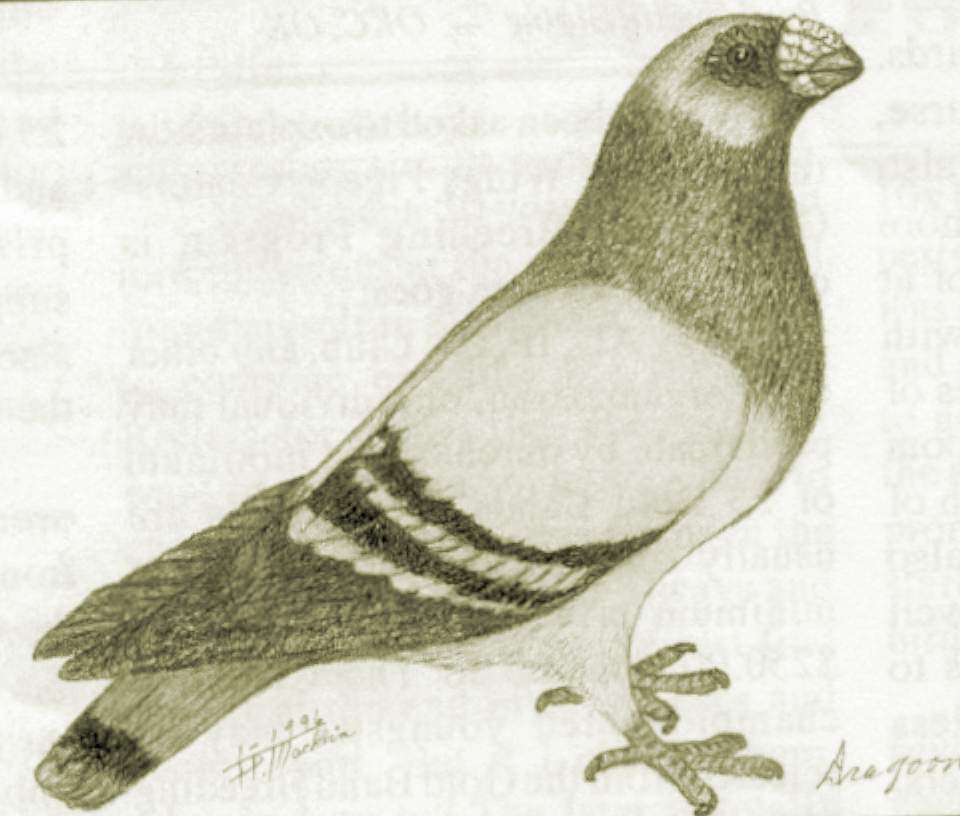
The Dragoon

by late H.P Macklin
The Dragoon variety originated in England. It is thought the Horseman pigeon (now extinct) was in the early breeding as well as the carrier and the present day racing homer. Around 1876, the dragoon was very popular in England.
Originally the variety was a flying bird, but during the 1900's it has been principally for exhibition purposes. Levi (1965) lists the following colors as popular: blues in barred or cheekered; the same in selfs and mealy reds; also selfs in yellow, white, black and grizzled design in blue, silver, and red. The variety is cleaned legged, smooth headed with a broad and nicely round skull. The upper beak wattle should he wedge- shaped. The beak is re mindful of a soft nosed .45 bullet, bluntly well developed. The Dragoon has always had some strong support in the U.S. and a round 1895-1905 was used to increase the size of squabbing Homers.
Schutte (Germany, 1971) claims the Dragoon has originally an English homing pigeon. It was related to the Carrier also. In body formation, earlier, resembled the Persian Carrier, but later on the pigeon was bred for a more horizontal level in body stance, bringing it to resemble more the Homer pigeon variety. The wattle is naturally very important in its formation. The eyes are surrounded with two rings of flesh, nicely developed and blue-gray in color with all blue, black, red cheekered and silver colored Dragoons. Flesh colored in reds, yellows, and white selfs. The beak wattle is only well developed on the upper beak but not as large as in the Carriers or Barbs and is powdered white.
Schutte in his latest German book (1994) says the Dragoon was known in Germany since 1735 by this English name and was nicknamed during the 19th century as the "messenger pigeon" Later, in Germany, around 1880, came the substitute, change in the Dragoon. The similarity to the Persian Carrier in body form was changing. In England, a different breeding program was evident. For instance, the "London Dragoon" was larger, body carriage had a higher reach and the weak battles were more strongly developed.
In Europe, in the meantime, a different breeding program was in progress. The pigeon was medium sized, but strongly built, with a forty- five degree upward direction in the body position. And likewise, an upwards holding of the head and back position. And likewise, an upwards holding of the head and back position to such an extent the Dragoon was referred to as the "Sky Looker" ("Himmelsgucker").
The head, between the eyes, is wide and shows a slight arching from eye cere and follows in an arch- rounding wedge-shaped wattle to the beak. The border lines should he good, showing no break in blending into the neck.
lower and upper sections should show similar size and strength. The desired position of the beak ends should be parallel the under half of the eye. The beak is dark in blues, checkers, blacks, mealy-reds and checks. Horn colored in pale blues and checks, flesh colored in mealy-yellow and cheeks, yellows, red and white; horn colored in the grizzled varieties.
The beak wattle should be short near the beak points, enlarging and rising slightly towards the forehead, which in older birds is more pronounced. The wattle is neat in texture, powdered white and not glossy over developed. It reaches its highest point
at the forehead junction.
The neck is robust and full to the shoulders, concisely medium length and blending nicely into the head. The breast is wide, full, nicely rounded and carried in an upward, outward appearance. The back is flat, wide at the shoulders and to the tail tapers off wedge shaped, with about a 45 degree downward slope. The wings are strong and wide, the wing bend being apparent. The flights rest on the relatively short tail and are carried evenly closed.The legs are positioned widely apart, rearward and are short and unfeathered. The shanks are sturdy. The feathering is hard and lays smoothly on the body.
The Dragoon shows the best quality and development for exhibition purposes in ages of 2 to 3 years, especially in the size of the wattles. Hens show a lesser development. Every time 1 see this proud pigeon 1 am reminded of a soldier suddenly snapping to "attention!!"